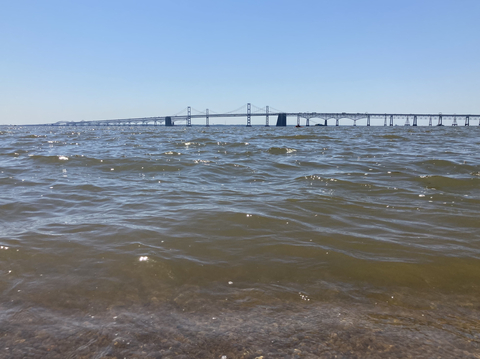A new look at the history of water quality in the Chesapeake Bay sheds light on how the estuary has responded to nutrient reduction efforts and why improvements have remained a major challenge.
University of Maryland Center for Environmental Science researchers looked at the Bay's historic response to efforts to reduce nutrients to minimize dead zones—areas with too little oxygen to support marine life—and found there is a pollution threshold after which it takes twice the effort to make a change.
"Once nutrient pollution crosses a threshold and the system enters a eutrophic state, it will take a much larger reduction to return to the original state," said study co-author Ming Li, a professor at the University of Maryland Center for Environmental Science.
The bay's low-oxygen zones, also called ‘dead zones’, are caused by excess nutrient pollution, primarily from agriculture and wastewater. The excess nutrients stimulate an overgrowth of algae, which then sinks and decomposes in the water, consuming oxygen. This is called eutrophication. The resulting low oxygen levels are insufficient to support most marine life and habitats in near-bottom waters, threatening the bay's crabs, oysters, and other fisheries.
Expanding dead zones over the decades have been linked to increased nutrient pollution, but this paper reveals that the system only responds to reductions until the amount of pollution crosses a certain threshold, then it takes twice the effort to see a change.
"As a result, the Chesapeake Bay has become recalcitrant to changes in nutrient loads, and larger reductions would be required to induce a complete reversal of eutrophication-induced hypoxia," said Li. "This may partly explain the modest reduction in Chesapeake Bay hypoxia since the implementation of nutrient management strategies in the mid-1980s."
This study examined the expansion of low-oxygen zones from 1950-1989, when the amount of nitrogen pollution in the Chesapeake Bay doubled. Previous analysis showed that the large expansion of hypoxia between 1950s and 1980s was correlated to increased nutrient pollution from rivers.
 Study site Chesapeake Bay. (Photo credit: University of Maryland)
Study site Chesapeake Bay. (Photo credit: University of Maryland)
Hypoxia results from a complex interplay of various physical and biogeochemical processes, and other factors may be having an impact, as well. The degradation of habitats on the bottom of the Bay, such as underwater grasses and oysters, may have changed the estuary's capacity to filter nutrients and sediment. The impacts of climate change since 1989, such as warming, sea level rise, and changing precipitation patterns and river flows, together with associated changes in nutrient runoffs, may alter key baselines impacting the functioning of coastal systems and their responses to eutrophication.
"Looking into the future, nutrient reduction strategies will need to be considered in the face of accelerated warming and sea level rise in the 21st century," said Li.
This research was made possible with financial support from the National Science Foundation and NOAA Ocean Acidification Program.
"What drove the nonlinear hypoxia response to nutrient loading in Chesapeake Bay during the 20th century?" was published in Science of the Total Environment by Wenfei Li and Ming Li of the University of Maryland Center for Environmental Science.
University of Maryland Center for Environmental Science scientists have been at the core of understanding the changes in the Chesapeake Bay since the 1920s. When Maryland first faced the disappearance of the Bay's underwater grasses in the 1970s, UMCES scientists were the first to demonstrate the problem -- over-nourishment caused by excess nutrients in the Bay -- and were key in helping determine the way forward to restoring Bay health.
The paper is dedicated to the memory of Michael Kemp, a pioneering ecosystems ecologist whose cutting-edge research influenced our understanding and management of the Chesapeake Bay and estuaries around the world. Working out of UMCES' Horn Point Laboratory on the Eastern Shore, his research on nitrogen cycling in the 1980s and 1990s contributed to the global understanding of the importance of sediments in nutrient cycling. His research has also made substantial contributions to understanding the global increase in coastal hypoxia and how nutrient reductions can lead to improvements in water quality.
Journal Reference:
- Wenfei Ni, Ming Li. What drove the nonlinear hypoxia response to nutrient loading in Chesapeake Bay during the 20th century? Science of The Total Environment, 2023; 861: 160650 DOI: 10.1016/j.scitotenv.2022.160650



